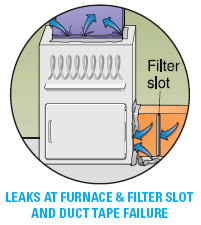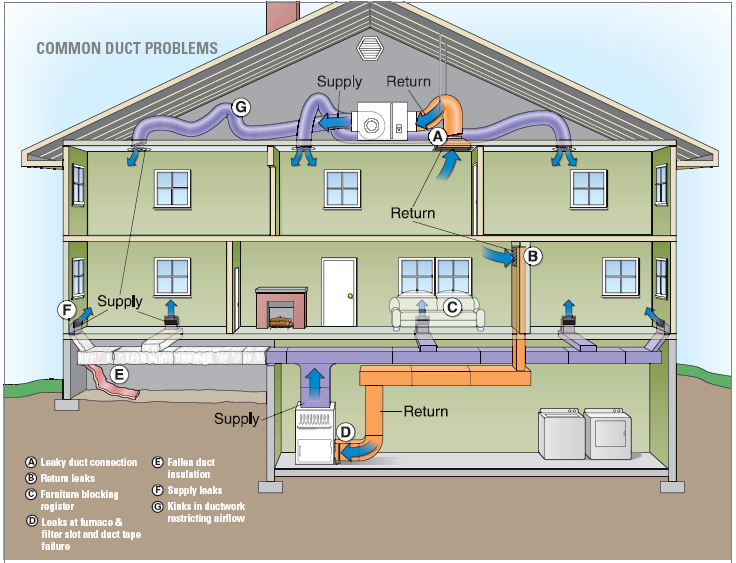HIGH UTILITY BILLS? STUFFY ROOMS?
DUSTY HOUSE?
It Could be Your Ducts.
A duct system that is well-designed and properly sealed can make your home more comfortable, more energy efficient, and safer. Here are some reasons why duct improvements are a wise investment:
Comfort
Sealing and insulating ducts can help with common comfort problems, such as rooms that are too hot in the summer or too cold in the winter.
Health
Sealing ducts can help improve indoor air quality by reducing the risks of pollutants entering ducts and circulating through your home. Fumes from household and garden chemicals, insulation particles, and dust can enter your duct system through leaks and can aggravate existing asthma and allergy problems.
Safety
During normal operation, gas appliances such as water heaters, clothes dryers, and furnaces release combustion gases, like carbon monoxide, through their ventilation systems. Leaking ductwork in your heating and cooling system may cause “backdrafting,” where these gases are drawn into the living space, rather than expelled to the outdoors. Sealing leaks can minimize this risk.
Save Money
Leaky ducts can reduce heating and cooling system efficiency by as much as 20 percent. Duct sealing and insulating increases efficiency, lowers your energy bills, and can often pay for itself in energy savings. Plus, if you’re planning to install new heating and cooling equipment, know that a well designed and sealed duct system may allow you to downsize to a smaller, less costly heating and cooling system.
Protect the Environment
Energy generation is one of the largest contributors to greenhouse gases. By sealing your ducts and reducing the amount of energy necessary to comfortably heat or cool your home, you can reduce the amount of air pollution generated.
HOW DUCTS WORK
Ducts are an integral part of a forced-air system, such as a furnace, heat pump, or central air conditioner. The job of ducts is to circulate heated or cooled air evenly to every room in a house. Ducts are commonly concealed in walls, ceilings, attics, basements, or crawl spaces. This can make them difficult to access and repair.
Poorly performing ducts often leak the air that you paid to heat and cool. Poorly performing ducts can cause your heating and cooling system to work harder to keep your home at a comfortable temperature.
 These conditions can be a sign of poorly performing ducts. These conditions can be a sign of poorly performing ducts.
-
High summer and winter utility bills.
-
Your system’s filters get dirty quickly.
-
Dirt streaks showing at the corners and connections of ducts.
-
Rooms are stuffy and never seem to feel comfortable.
-
Your ducts are located in the attic or crawl space and they are not insulated or have damaged insulation.
-
Flexible ducts are tangled or kinked.
-
The spaces between the floor joists and wall studs have been enclosed and are being used to move air. When these cavities are used as ductwork, they are usually very leaky. You can detect this in the basement if sheet metal is nailed to the ceiling between the floor joists.
A well-designed, sealed, and insulated duct system will improve your system’s ability to consistently cool and heat every room in your home.

REPAIRING AND MAINTAINING YOUR DUCTS
If you suspect you have poorly performing ducts, EPA recommends using a professional contractor for duct improvements. Usually, contractors who install heating and cooling systems also repair ductwork. Typically, when making improvements to your duct system, a contractor will:
-
Inspect the whole duct system, including attic and crawl spaces. The contractor will measure air flow and duct leakage with diagnostic equipment and remove registers and grills to ensure that ducts are properly connected.
-
Evaluate how well the system’s supply air and return air is balanced for better air flow. Many systems have air return ducts that are too small. Re-evaluate airflow after repairs are completed.
-
Seal all leaks and connections with mastic, metal tape, or an aerosol-based sealant. Duct tape should never be used because it will not last.
-
Seal all registers and grills tightly to the ducts.
-
Insulate ducts in unconditioned areas, like attics and crawl spaces, with duct insulation that carries an R value of 6 or higher.
-
Repair damaged and disconnected ducts and straighten out flexible ducts that are tangled or crushed.
-
Include a new filter as part of any duct system improvements.
-
To make sure there is no backdrafting of gas or oil-burning appliances, conduct a combustion safety test after ducts are sealed.
Source: U. S. Environmental Protection Agency
|